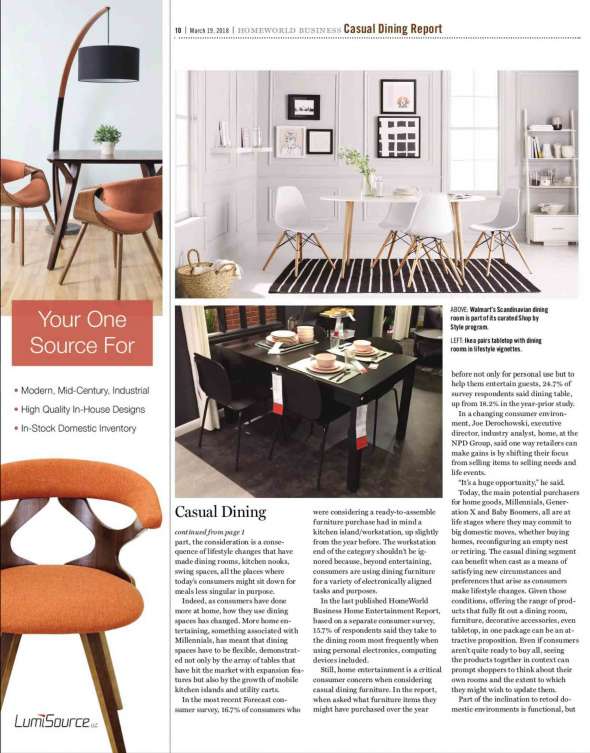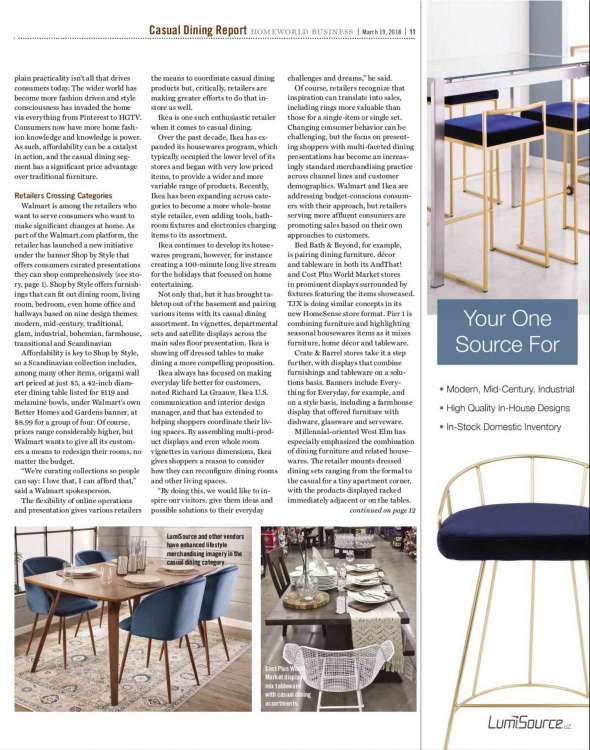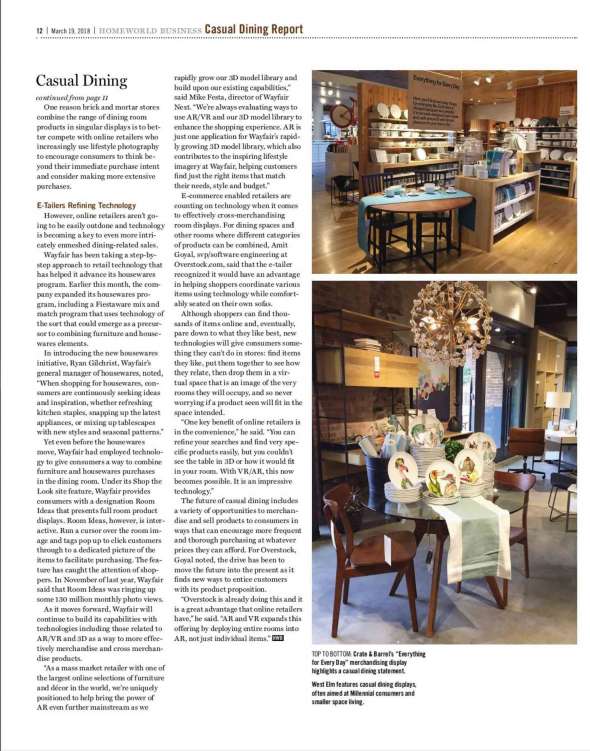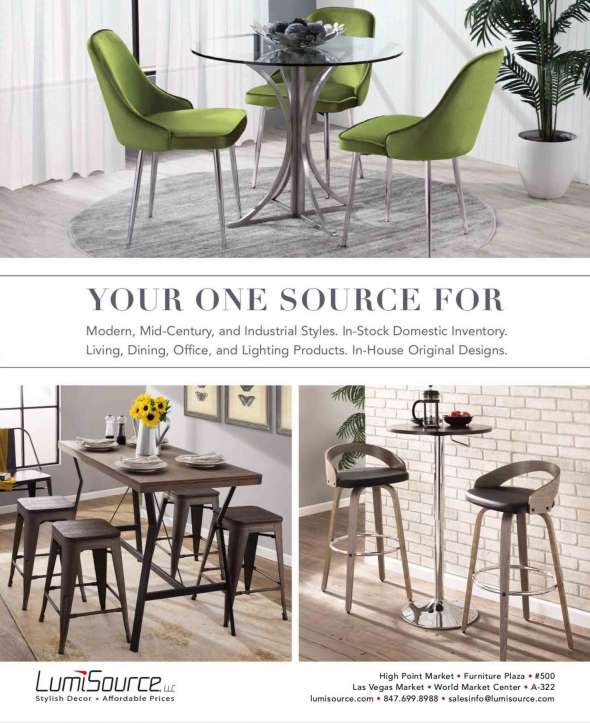Casual dining is making strides with shoppers and can look forward to gains moving forward as consumer lifestyles, product development trends and retail evolution provide fertile ground for opportunity.
Lower cost, better quality and more fashionable casual dining furniture can give consumers reason to think about freshening their eating environments regularly, just as they have other home spaces. Today, retailers are taking a more comprehensive approach to the sale of dining furniture, crossing segment and category lines to create merchandising sets that prompt consumers to reconsider the occasion and how they can make it more satisfying both for family and guests.
Consumers have been rethinking dining spaces, whether dedicated or improvised, for some time now. In part, the consideration is a consequence of lifestyle changes that have made dining rooms, kitchen nooks, swing spaces, all the places where today’s consumers might sit down for meals less singular in purpose.
Indeed, as consumers have done more at home, how they use dining spaces has changed. More home entertaining, something associated with Millennials, has meant that dining spaces have to be flexible, demonstrated not only by the array of tables that have hit the market with expansion features but also by the growth of mobile kitchen islands and utility carts.
In the most recent Forecast consumer survey, 16.7% of consumers who were considering a ready-to-assemble furniture purchase had in mind a kitchen island/workstation, up slightly from the year before. The workstation end of the category shouldn’t be ignored because, beyond entertaining, consumers are using dining furniture for a variety of electronically aligned tasks and purposes.
In the last published HomeWorld Business Home Entertainment Report, based on a separate consumer survey, 15.7% of respondents said they take to the dining room most frequently when using personal electronics, computing devices included.
Still, home entertainment is a critical consumer concern when considering casual dining furniture. In the report, when asked what furniture items they might have purchased over the year before not only for personal use but to help them entertain guests, 24.7% of survey respondents said dining table, up from 18.2% in the year-prior study.
In a changing consumer environment, Joe Derochowski, executive director, industry analyst, home, at the NPD Group, said one way retailers can make gains is by shifting their focus from selling items to selling needs and life events.
“It’s a huge opportunity,” he said.
Today, the main potential purchasers for home goods, Millennials, Generation X and Baby Boomers, all are at life stages where they may commit to big domestic moves, whether buying homes, reconfiguring an empty nest or retiring. The casual dining segment can benefit when cast as a means of satisfying new circumstances and preferences that arise as consumers make lifestyle changes. Given those conditions, offering the range of products that fully fit out a dining room, furniture, decorative accessories, even tabletop, in one package can be an attractive proposition. Even if consumers aren’t quite ready to buy all, seeing the products together in context can prompt shoppers to think about their own rooms and the extent to which they might wish to update them.
Part of the inclination to retool domestic environments is functional, but plain practicality isn’t all that drives consumers today. The wider world has become more fashion driven and style consciousness has invaded the home via everything from Pinterest to HGTV. Consumers now have more home fashion knowledge and knowledge is power. As such, affordability can be a catalyst in action, and the casual dining segment has a significant price advantage over traditional furniture.
Retailers Crossing Categories
Walmart is among the retailers who want to serve consumers who want to make significant changes at home. As part of the Walmart.com platform, the retailer has launched a new initiative under the banner Shop by Style that offers consumers curated presentations they can shop comprehensively (see story, page 1). Shop by Style offers furnishings that can fit out dining room, living room, bedroom, even home office and hallways based on nine design themes: modern, mid-century, traditional, glam, industrial, bohemian, farmhouse, transitional and Scandinavian
Affordability is key to Shop by Style, so a Scandinavian collection includes, among many other items, origami wall art priced at just $5, a 42-inch diameter dining table listed for $119 and melamine bowls, under Walmart’s own Better Homes and Gardens banner, at $8.99 for a group of four. Of course, prices range considerably higher, but Walmart wants to give all its customers a means to redesign their rooms, no matter the budget.
“We’re curating collections so people can say: I love that, I can afford that,” said a Walmart spokesperson.
The flexibility of online operations and presentation gives various retailers the means to coordinate casual dining products but, critically, retailers are making greater efforts to do that in-store as well.
Ikea is one such enthusiastic retailer when it comes to casual dining.
Over the past decade, Ikea has expanded its housewares program, which typically occupied the lower level of its stores and began with very low priced items, to provide a wider and more variable range of products. Recently, Ikea has been expanding across categories to become a more whole-home style retailer, even adding tools, bathroom fixtures and electronics charging items to its assortment.
Ikea continues to develop its housewares program, however, for instance creating a 100-minute long live stream for the holidays that focused on home entertaining.
Not only that, but it has brought tabletop out of the basement and pairing various items with its casual dining assortment. In vignettes, departmental sets and satellite displays across the main sales floor presentation, Ikea is showing off dressed tables to make dining a more compelling proposition.
Ikea always has focused on making everyday life better for customers, noted Richard La Graauw, Ikea U.S. communication and interior design manager, and that has extended to helping shoppers coordinate their living spaces. By assembling multi-product displays and even whole room vignettes in various dimensions, Ikea gives shoppers a reason to consider how they can reconfigure dining rooms and other living spaces.
“By doing this, we would like to inspire our visitors, give them ideas and possible solutions to their everyday challenges and dreams,” he said.
Of course, retailers recognize that inspiration can translate into sales, including rings more valuable than those for a single-item or single set. Changing consumer behavior can be challenging, but the focus on presenting shoppers with multi-faceted dining presentations has become an increasingly standard merchandising practice across channel lines and customer demographics. Walmart and Ikea are addressing budget-conscious consumers with their approach, but retailers serving more affluent consumers are promoting sales based on their own approaches to customers.
Bed Bath & Beyond, for example, is pairing dining furniture, décor and tableware in both its AndThat! and Cost Plus World Market stores in prominent displays surrounded by fixtures featuring the items showcased. TJX is doing similar concepts in its new HomeSense store format. Pier 1 is combining furniture and highlighting seasonal housewares items as it mixes furniture, home décor and tableware.
Crate & Barrel stores take it a step further, with displays that combine furnishings and tableware on a solutions basis. Banners include Everything for Everyday, for example, and on a style basis, including a farmhouse display that offered furniture with dishware, glassware and serveware.
Millennial-oriented West Elm has especially emphasized the combination of dining furniture and related housewares. The retailer mounts dressed dining sets ranging from the formal to the casual for a tiny apartment corner, with the products displayed racked immediately adjacent or on the tables.
One reason brick and mortar stores combine the range of dining room products in singular displays is to better compete with online retailers who increasingly use lifestyle photography to encourage consumers to think beyond their immediate purchase intent and consider making more extensive purchases.
E-Tailers Refining Technology
However, online retailers aren’t going to be easily outdone and technology is becoming a key to even more intricately enmeshed dining-related sales.
Wayfair has been taking a step-by-step approach to retail technology that has helped it advance its housewares program. Earlier this month, the company expanded its housewares program, including a Fiestaware mix and match program that uses technology of the sort that could emerge as a precursor to combining furniture and housewares elements.
In introducing the new housewares initiative, Ryan Gilchrist, Wayfair’s general manager of housewares, noted, “When shopping for housewares, consumers are continuously seeking ideas and inspiration, whether refreshing kitchen staples, snapping up the latest appliances, or mixing up tablescapes with new styles and seasonal patterns.”
Yet even before the housewares move, Wayfair had employed technology to give consumers a way to combine furniture and housewares purchases in the dining room. Under its Shop the Look site feature, Wayfair provides consumers with a designation Room Ideas that presents full room product displays. Room Ideas, however, is interactive. Run a cursor over the room image and tags pop up to click customers through to a dedicated picture of the items to facilitate purchasing. The feature has caught the attention of shoppers. In November of last year, Wayfair said that Room Ideas was ringing up some 130 million monthly photo views.
As it moves forward, Wayfair will continue to build its capabilities with technologies including those related to AR/VR and 3D as a way to more effectively merchandise and cross merchandise products.
“As a mass market retailer with one of the largest online selections of furniture and décor in the world, we’re uniquely positioned to help bring the power of AR even further mainstream as we rapidly grow our 3D model library and build upon our existing capabilities,” said Mike Festa, director of Wayfair Next. “We’re always evaluating ways to use AR/VR and our 3D model library to enhance the shopping experience. AR is just one application for Wayfair’s rapidly growing 3D model library, which also contributes to the inspiring lifestyle imagery at Wayfair, helping customers find just the right items that match their needs, style and budget.”
E-commerce enabled retailers are counting on technology when it comes to effectively cross-merchandising room displays. For dining spaces and other rooms where different categories of products can be combined, Amit Goyal, svp/software engineering at Overstock.com, said that the e-tailer recognized it would have an advantage in helping shoppers coordinate various items using technology while comfortably seated on their own sofas.
Although shoppers can find thousands of items online and, eventually, pare down to what they like best, new technologies will give consumers something they can’t do in stores: find items they like, put them together to see how they relate, then drop them in a virtual space that is an image of the very rooms they will occupy, and so never worrying if a product seen will fit in the space intended.
“One key benefit of online retailers is in the convenience,” he said. “You can refine your searches and find very specific products easily, but you couldn’t see the table in 3D or how it would fit in your room. With VR/AR, this now becomes possible. It is an impressive technology.”
The future of casual dining includes a variety of opportunities to merchandise and sell products to consumers in ways that can encourage more frequent and thorough purchasing at whatever prices they can afford. For Overstock, Goyal noted, the drive has been to move the future into the present as it finds new ways to entice customers with its product proposition.
“Overstock is already doing this and it is a great advantage that online retailers have,” he said. “AR and VR expands this offering by deploying entire rooms into AR. not just individual items.”







